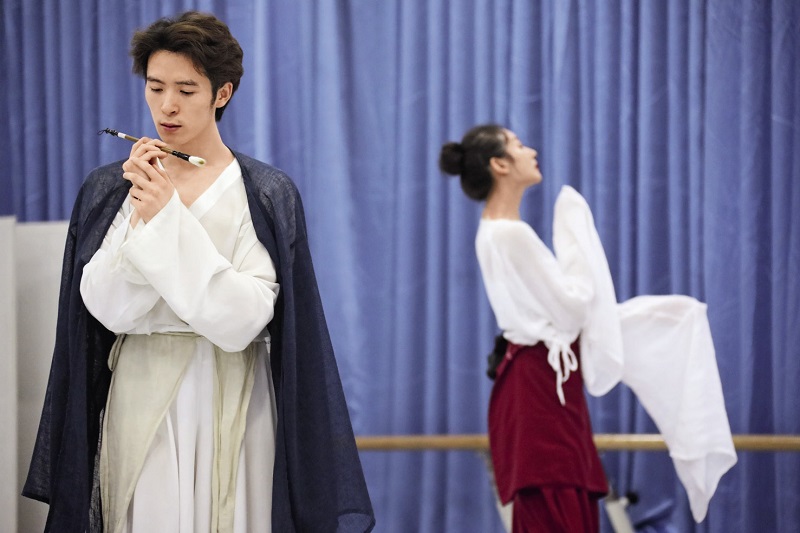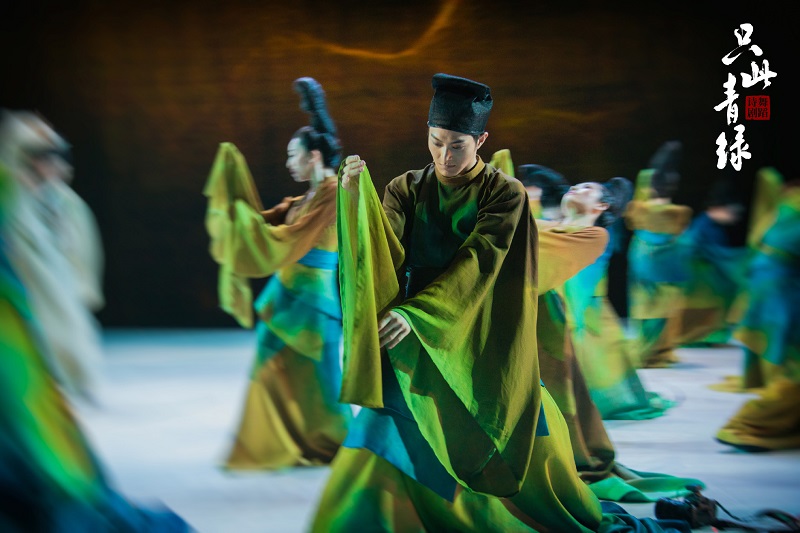Bringing Cultural Relics onto the Stage
The Journey of a Legendary Landscape Painting (referred hereafter as The Journey) is a poetic traditional Chinese dance drama that has created a sensation this year. A factor contributing to its astonishing number of views is that it was inspired by a world-renowned Chinese landscape painting, A Thousand Miles of Rivers and Mountains, which has a history dating back 800 years.
“No depiction of the painting A Thousand Miles of Rivers and Mountains is shown throughout the dance drama of The Journey. Despite its absence, after watching the drama, the audience is able to feel the intense vibe presented by the dance and understand the spirit which is portrayed in the painting. That is the goal our team seeks to achieve. The dance is not merely a reproduction of the painting, but rather is a medium for carrying on its spirit and a tribute to each creator and inheritor of fine traditional Chinese culture throughout history,” said Xu Junrui, the playwright for the drama in an interview with China Today.
With a whopping 247 million views online, the poetic dance The Journey became a hit after its premier performance at the National Center for the Performing Arts in Beijing last August.
A section of the drama was performed on Bilibili’s (a popular streaming platform in China) 2022 New Year’s Eve Gala and drew an audience of 180 million viewers who watched it live online. And its debut on the Spring Festival Gala of the Year of the Tiger received 1.7 billion views on weibo hashtag topics. Its theater tickets sold out in an instant after each release. When talking about the dance going viral, Xu said that cultural relics are physical, but the spirit which they convey can be felt and envisioned.
The greatest challenge facing the actors of The Journey was how to create a resonating chord between the audience living in a modern era and the ancient painting by means of time-space crisscrossing. This challenge, though daunting, also turned out to boost the drama’s massive popularity.

The Journey of a Legendary Landscape Painting, a poetic traditional Chinese dance drama, created a sensation in 2022.
“Act” the Painting
The painting A Thousand Miles of Rivers and Mountains was drawn by a young painter named Wang Ximeng during the Northern Song Dynasty (960–1127), who at the age of 18 completed the painting within just six months. On the 12-meter-long scroll, he primarily used two types of pigments for depicting mountain ranges, fabulous lakes and rivers, villages dotting the landscape, and lively pine trees. From the first to the last stroke, the masterpiece went through five stages of coloring: first stage was drawing an ink sketch, second stage was coloring it with ocher, third with malachite, fourth was applying another layer of malachite, and finally azurite was applied. This process gave this landscape work stunning shades.
One may ask, “How did the choreographers of The Journey come up with the correlation between the painting and dancing by just looking at such a static landscape painting?” Xu explained that dancing and painting share a natural connection where both have a seemingly silent appearance but are virtually loud on the inside. Dancers’ body language can present the pleasant aura of paintings. “In 2017, we attended a special exhibition of A Thousand Miles of Rivers and Mountains at the Forbidden City and were captivated by the painting’s amazing blue and green colors. The painting does not portray any hero or character, but it contains a lot of traditional cultural concepts,” Xu said.
Due to the fact that few accounts of the painter Wang Ximeng can be found in historical records, the drama team faced the challenge of finding an appropriate story to touch the spectators. The creation team therefore set their eyes on the whole set of tools required to finish the painting, such as the paper, brushes, and ink as well as the traditional techniques required to make those tools. They hope to pay tribute to the unsung craftsmen who contributed to and were involved in creating the traditional culture inheritance.
Based on all the steps necessary for finishing the painting, The Journey is composed of seven sections – Scroll Unfolding, Seal Script Asking, Silk Singing, Stone Search, Penmanship Practice, Ink Milling, and Drawing, so that the audience can feel the poetic vibe in the painting through abstract concepts and unique choreography. In the drama, a researcher of the Palace Museum, in order to better understand the painting A Thousand Miles of Rivers and Mountains, travels back in time and witnesses the days of Wang Ximeng painting the scroll. By following the scroll opener, audiences can observe not only the painter’s hard effort, but also the craftsmen working far from the painting – the seal carvers’ accuracy and fine skills, the silk makers’ concentration on every thread, the masons’ search for stones in the mountains, the brush makers’ careful selection of each hair, and the tens of thousands of times it took for ink makers to pound the ink ingredients.
On the stage, the towering buns on the dancers’ heads and their blue and green costumes are the expression of the lush mountains. The choreographer designed a series of beautiful movements for the lead dancer Qinglü (literally meaning blue and green), such as waiting, looking at the moon, falling clouds, pondering, wandering alone, dangerous peaks and lying rocks. The group dance actresses are transformed into steep mountains and green hills, whose movements represent landscapes of mountain ranges and the winding rivers artistically. These images are fresh and have never been presented in this way, and by doing so, the painting comes “alive” on the stage.

The lead dancers of The Journey practicing during a rehearsal.
A Dialogue Traversing Time and Space
Xu Junrui said that it took nearly one year and eight months to finish the script of The Journey. With heartily respect for traditional culture, the team had studied a number of poems and paintings from the Song Dynasty and consulted a host of researchers of cultural relics, calligraphers, painters, and researchers of Song Dynasty culture. They then carefully edited every detail in order to present the best version to the audience.
The team has also invited intangible cultural heritage inheritors of the crafts to make traditional painting pigments, Anhui inksticks, and Xuan ricepaper to the studio to give suggestions and advice to the actors from the perspective of techniques used to make real tools. Xu said the scenes of tool making had been adapted to the artistic aesthetics in the play, but thanks to the inheritors’ help, the production process presented on the stage can be seen as academic and professional.
While mulling over the storyline, Xu came to realize the great value of A Thousand Miles of Rivers and Mountains. It is a long span of time and space over 900 years from its birth to today. Passing on a cultural legacy is the ultimate goal they are pursuing.
There are no actor’s lines in The Journey, but the full text of the final script has more than 7,000 words, outlining a clear plot and storyline. The script was modified five times by Xu before they settled on the final version.
While working on the fifth version, Xu and the team decided to add a role, which they called “scroll opener,” a researcher from the Palace Museum. On one side of the stage, there is a scene from over 900 years ago when Wang Ximeng is about to make final touches on the painting. On the other side of the stage, there is a modern scene, A Thousand Miles of Rivers and Mountains is going to be displayed in an exhibition. The scroll opener is inspecting the work when suddenly a time chaos is triggered and he falls into the mind of Wang. By doing so, an interwoven connection between the painter, craftsmen, and scroll opener is portrayed.
To better present the scroll opening of a traditional Chinese painting, the stage was turned into multiple concentric circles. There is a curtain attached to a circular hanger in the air and on the stage are five rotatable rings divided by four circles. When performing, those rings at the bottom and the machines in the air rotate simultaneously, adding great difficulty to stage management. Besides, in order to present more impressive scenes, The Journey team paid much attention to the ratio and blank of the motion and static poses, the dance moves and expressions of the actors, to make each detail exhibit a sophisticated design.

An actor performing his part of the dance drama The Journey.
Revive Traditional Culture
Xu confessed that the team was tense about the audience review before The Journey’s premier. As it is not a conventional work, it is unprecedented even among the genre of dance dramas. On the night of its debut, the whole team intently watched each move from the backstage and when the curtain fell, tears came to many eyes.
After the premiere, many viewers shared their reflections online. “What I found amazing was that, when the audience resonates with you, they do not accept everything that you give them,” Xu said, “In fact, each member of the audience is a craftsman and a scroll opener when they go to the theater and unfold the scroll, they are completing the work along with us by echoing their own life experience. We see people with backgrounds in archaeology, anthropology, sociology, guqin performance, painting, and other professions, all interpreting The Journey from their own perspectives.” Since the premiere, the team has continued to collect audience feedback, to help them make changes and finetune the play. As general director Zhou Liya said, “There is no final version of The Journey, there is only the best version.”
During recent years, with the revival of traditional culture, there has been a slew of popular programs that have drawn inspiration from ancient national treasures. A host of dancing programs which feature both traditional Chinese cultural roots and modern aesthetics have left deep impressions on spectators. They include blockbusters like Night Banquet in Tang Dynasty Palace that mimics pottery figures of Tang Dynasty, a Sanxingdui creative dance Golden Face, and the dance drama Five Stars Rise from the East inspired by a brocade arm protector from the first century BC.
Xu said that the recent revival of traditional culture helped The Journey succeed. Some young people have attended the show in Song-styled robes, and some audience members came to the theater for a second view of the play and shared their feelings again online.
At present, as the younger generation is becoming more conscious of their identity and Chinese culture, it is an appropriate time and environment to revive traditional culture. Xu said, “As artists, we are very lucky to live in an era favorable for art creation. We should seize this opportunity to discover more gems in Chinese civilization.”
blog comments powered by